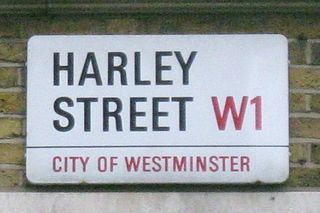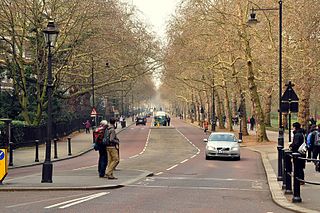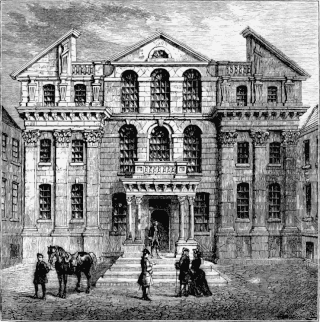
King Street is a street in the St James's district of the City of Westminster. It runs south-west to north-east from St James's Street to St James's Square.

King Street is a street in the St James's district of the City of Westminster. It runs south-west to north-east from St James's Street to St James's Square.
King Street was probably named after Charles II, and is first mentioned in ratebooks in 1673, having been known before as Charles Street. [1]
The 1200-seat St James's Theatre on the corner with Duke Street opened in 1835, but was demolished in 1957, despite widespread protests.
Notable occupiers include the principal London premises of the auctioneers Christie's, [2] and Palamon Capital Partners. [3]

The Northern line is a London Underground line that runs between North London and South London. It is printed in black on the Tube map. It carries more passengers per year than any other Underground line – around 340 million in 2019 – making it the busiest tube line in London. The Northern line is unique on the Underground network in having two different routes through central London, two southern branches and two northern branches. Despite its name, it does not serve the northernmost stations on the Underground, though it does serve the southernmost station at Morden, the terminus of one of the two southern branches.

Harley Street is a street in Marylebone, Central London, named after Edward Harley, 2nd Earl of Oxford and Earl Mortimer. Since the 19th century it has housed a large number of private specialists in medicine and surgery.

Spencer House is a historic town house at 27 St James's Place in the St James's area of Westminster, Greater London, England. The house is Grade I listed on the National Heritage List for England.

Hanover Square is a green square in Mayfair, Westminster, south west of Oxford Circus where Oxford Street meets Regent Street. Six streets converge on the square which include Harewood Place with links to Oxford Street, Princes Street, Hanover Street, Saint George Street, Brook Street and Tenderden Street, linking to Bond Street and Oxford Street.

Horse Guards is a historic building in the City of Westminster, London, between Whitehall and Horse Guards Parade. It was built in the mid-18th century, replacing an earlier building, as a barracks and stables for the Household Cavalry. The current and previous buildings were, between the early 18th century and 1858, the main military headquarters for the British Empire. Horse Guards originally formed the entrance to the Palace of Whitehall and later St James's Palace; for that reason it is still ceremonially defended by the King's Life Guard.

White's is a gentlemen's club in St James's, London. Founded in 1693 as a hot chocolate shop in Mayfair, it is London's oldest club and therefore the oldest private members' club in the world. It moved to its current premises on St James's Street in 1778.

Coade stone or Lithodipyra or Lithodipra is stoneware that was often described as an artificial stone in the late 18th and early 19th centuries. It was used for moulding neoclassical statues, architectural decorations and garden ornaments of the highest quality that remain virtually weatherproof today.

Dover Street is a street in Mayfair, London. The street is notable for its Georgian architecture as well as the location of historic London clubs and hotels, which have been frequented by world leaders and historic figures in the arts. It also hosts a number of contemporary art galleries. An equestrian sculpture by Elisabeth Frink stands on the junction of Dover Street and Piccadilly, opposite the Ritz Hotel.

Birdcage Walk is a street in the City of Westminster in London. It runs east–west as a continuation of Great George Street, from the crossroads with Horse Guards Road and Storey's Gate, with the Treasury building and the Institution of Mechanical Engineers on the northeast corner, to a junction with Buckingham Gate, at the southeast corner of Buckingham Palace. St. James's Park lies to the north, whilst to the south are the backs of buildings on Old Queen Street, Queen Anne's Gate and Petty France, and, at the western end, the Wellington Barracks of the Brigade of Guards.

Brown's Hotel is a 5-star hotel in Mayfair, London, established in 1832 and owned by Rocco Forte Hotels since July 2003. It is London's oldest luxury hotel, never having been renamed, rebuilt or relocated. Famous visitors include US President Franklin Roosevelt, Mahatma Gandhi and Diana, Princess of Wales.

Northampton Square, a green town square, is in a corner of Clerkenwell projecting into Finsbury, in Central London. It is between Goswell Road and St John Street, has a very broad pedestrian walkway on the north-west side between university buildings and is fronted chiefly by main buildings of City, University of London.

St Edmund, King and Martyr, is an Anglican church in Lombard Street, in the City of London, dedicated to St Edmund the Martyr. From 2001 it housed the London Centre for Spirituality, renamed the London Centre for Spiritual Direction, but is still a consecrated church. Since 2019, Imprint Church organises regular worship inside of the building.

Crockford's, the popular name for William Crockford's St James's Club was a London gentlemen's club, now dissolved. It was established in 1823, closed in 1845, re-founded in 1928 and closed in 1970. One of London's older clubs, it was centred on gambling and maintained a somewhat raffish and raucous reputation. It was founded by William Crockford who employed Benjamin Wyatt and Philip Wyatt to construct the city's most opulent palace of gentlemanly pleasure, which opened in November 1827. and he employed two of London's finest chefs of the time, Louis Eustache Ude and then Charles Elmé Francatelli to feed its members, food and drink being supplied free after midnight.

The Camberwell Collegiate School was a private school in Camberwell, London, England. It was located on the eastern side of Camberwell Grove, directly opposite the Grove Chapel.

St Thomas Syriac Orthodox Cathedral Acton is a Syriac Orthodox Cathedral in Acton, London, England, formerly known as St Saviour's Centre for the Deaf Anglican church, which was a social centre for deaf people, and the first and only purpose-built church for deaf people as such. St Saviour's was the central location for the London Diocesan Chaplaincy among Deaf and Deafblind people. The church and social centre closed in 2014 following a loss of funding, and insufficient financial reserves to maintain the premises. The final church service was held on Wednesday 24 September 2014, at which the Bishop of Willesden officiated.

The Old Red Lion is a pub at 72 High Holborn on the corner with Red Lion Street, Holborn, London.

Monmouth House was a 17th-century mansion in Soho Square built for the Duke of Monmouth, the oldest illegitimate son of King Charles II. After the Duke's execution for attempting to lead a rebellion against the unpopular Catholic successor to Charles, James II, the house was owned by the Bateman family and loaned to various important people including the French ambassador before being demolished in 1773.

The Lefevre Gallery was an art gallery in London, England, operated by Alex. Reid & Lefevre Ltd.

Trump Street is a street in the City of London that was originally known as Trumpadere Street, probably after the trumpet or horn makers who once worked there or in the adjacent Trump Alley. It was built after the Great Fire of London (1666) but completely destroyed by bombing during the Second World War and has since been entirely rebuilt.

The Bull and Mouth Inn was a coaching inn in the City of London that dated from before the Great Fire of London in 1666. It was located between Bull and Mouth Street in the north and Angel Street in the south. It was once an important arrival and departure point for coaches from all over Britain, but particularly for the north of England and Scotland. It became the Queen's Hotel in 1830 but was demolished in 1887 or 1888 when new post office buildings were built in St Martin's Le Grand.
![]() Media related to King Street, St James's at Wikimedia Commons
Media related to King Street, St James's at Wikimedia Commons